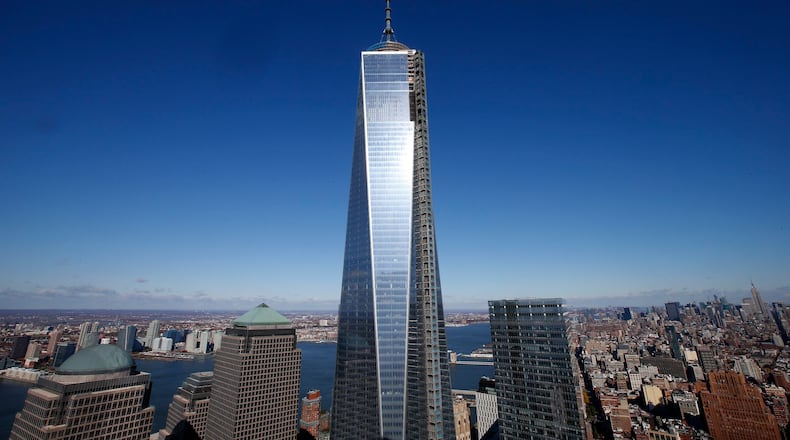A Gwinnett County architect says the design for One World Trade Center was stolen from his 1999 master’s thesis, according to a federal lawsuit filed this week.
Jeehoon Park, principal of Qube Architecture in Suwanee, claims another architecture firm, a construction company and entities controlled by the Port Authority of New York and New Jersey violated his copyright on a design in the creation of the highly recognizable building. The lawsuit, filed Wednesday in U.S. District Court, names Skidmore, Owings & Merrill LLP, Tishman Construction Corporation and LLCs controlled by the Port Authority of New York and New Jersey as defendants.
The suit claims that employees of the architecture firm, including Parks’ master’s thesis adviser, saw his design on several occasions and copied it for the trade center building without crediting him.
Suit: Man died after falling into deep fryer at Gwinnett Publix
Gwinnett man wants to build farm-centered community with 32 homes
“The form of One World Trade Center is a simple and iconic geometric form and SOM has shown, countless times now, the origins of its concept and the development of its design,” said Elizabeth Kubany, a spokesperson for Skidmore, Owings & Merrill, in a statement. “This lawsuit feels like an attempt to get attention or money and we are certain this claim will be found to be baseless.”
Tishman declined to comment. The Port Authority did not return requests for comment.
The Manhattan skyscraper, opened in 2014, was built on the grounds of the World Trade Center, which was destroyed in the Sept. 11, 2001 terrorist attacks. Known colloquially as the Freedom Tower, it stands 1,776 feet high, making it the tallest building in the Western Hemisphere and the sixth tallest on earth.
Park designed his thesis project, Chicago’s Cityfront Center ‘99, as a student at the College of Architecture at the Illinois Institute of Technology between 1997 and 1999. Park retained a copyright for the design, the suit said.
He filed for a copyright on the design in May of this year in preparation for the lawsuit, but copyright legally exists upon the moment of creation, said Dan Kent, Park’s attorney.
Ahmad Abdelrazaq, an associate partner at Skidmore, Owings & Merrill was one of Park’s thesis advisors, the suit says. Abdelrazaq is not named as a defendant in the lawsuit.
Cityfront ‘99 was also displayed at the College of Architecture for six years and published in a book, according to the suit. Multiple other members of the firm served as lecturers, professors, board members and guests of the school, making it likely they visited the lobby where Cityfront '99 was displayed, the suit says.
Access to the plaintiff’s work by the defendant is important in copyright cases, said Kean DeCarlo, an adjunct professor of intellectual property law at Georgia State University law school.
“The judge looks at whether they have access to the copyright,” DeCarlo said. “If you’re an advisor, hopefully you’re intimate with your students’ work, and that intimacy allows access.”
An image of Cityfront ‘99 also appeared in the 2006 film “The Lake House,” the suit says.
Credit: U.S. District Court for the Southern District of New York, Manhattan Division
Credit: U.S. District Court for the Southern District of New York, Manhattan Division
The buildings share "substantially similar exterior cross-sectional shapes ... at comparable floor levels," the suit said. Those similarities were noted in a 2010 book, "High-Rise and Long-Span Research at Illinois Institute of Technology: The Legacy of Myron Goldsmith and David C. Sharpe," the suit said.
In copyright cases involving architecture, plaintiffs must establish that specific copyrighted features from their design or diagram were copied, DeCarlo said.
“Most houses have walls and a roof. Just having that won’t protect you,” DeCarlo said. “These things end up being very nuanced arguments, but you can get protections on the design. The question is: Was that copyrightable and what was actually produced in the piece?”
Skidmore, Owings & Merrill views the lawsuit as “particularly suspect” because it was filed 12 years after the design was publicly revealed and four years after construction ended. Park became aware of the building “not too long ago,” Kent said.
“We believe we’re well within the copyright statute of limitations,” Kent said. “Mr. Park didn’t fully understand his legal rights until he came to us recently. He didn’t fully understand what he could do about what he saw.”
The suit accuses the defendants of copyright infringement and false advertising. It asks for financial damages for Park and permanent injunctions against the defendants preventing them from further claiming credit for the design.
About the Author
The Latest
Featured


